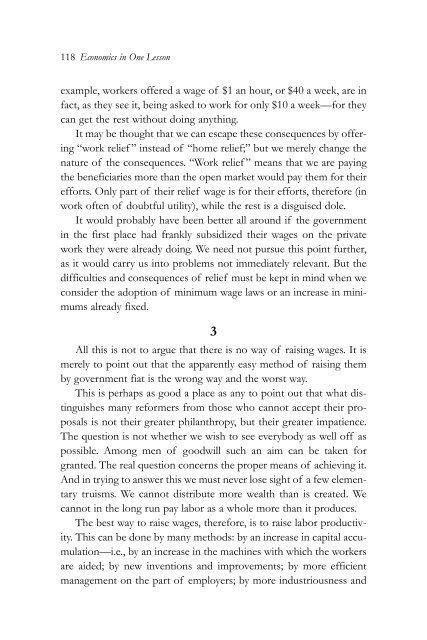1gDdM7w
1gDdM7w
1gDdM7w
- No tags were found...
Create successful ePaper yourself
Turn your PDF publications into a flip-book with our unique Google optimized e-Paper software.
118 Economics in One Lessonexample, workers offered a wage of $1 an hour, or $40 a week, are infact, as they see it, being asked to work for only $10 a week—for theycan get the rest without doing anything.It may be thought that we can escape these consequences by offering“work relief ” instead of “home relief;” but we merely change thenature of the consequences. “Work relief ” means that we are payingthe beneficiaries more than the open market would pay them for theirefforts. Only part of their relief wage is for their efforts, therefore (inwork often of doubtful utility), while the rest is a disguised dole.It would probably have been better all around if the governmentin the first place had frankly subsidized their wages on the privatework they were already doing. We need not pursue this point further,as it would carry us into problems not immediately relevant. But thedifficulties and consequences of relief must be kept in mind when weconsider the adoption of minimum wage laws or an increase in minimumsalready fixed.3All this is not to argue that there is no way of raising wages. It ismerely to point out that the apparently easy method of raising themby government fiat is the wrong way and the worst way.This is perhaps as good a place as any to point out that what distinguishesmany reformers from those who cannot accept their proposalsis not their greater philanthropy, but their greater impatience.The question is not whether we wish to see everybody as well off aspossible. Among men of goodwill such an aim can be taken forgranted. The real question concerns the proper means of achieving it.And in trying to answer this we must never lose sight of a few elementarytruisms. We cannot distribute more wealth than is created. Wecannot in the long run pay labor as a whole more than it produces.The best way to raise wages, therefore, is to raise labor productivity.This can be done by many methods: by an increase in capital accumulation—i.e.,by an increase in the machines with which the workersare aided; by new inventions and improvements; by more efficientmanagement on the part of employers; by more industriousness and


